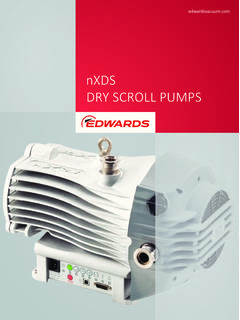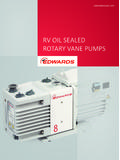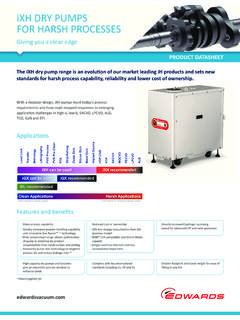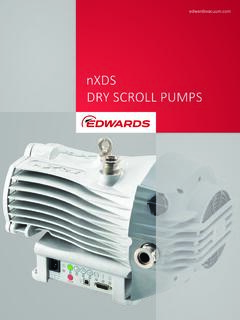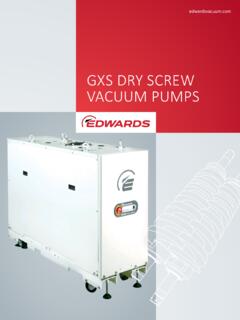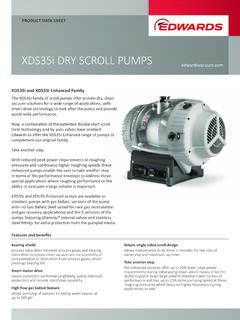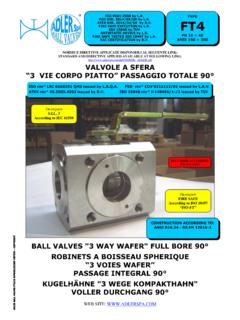Transcription of PRODUCT CATALOGUE 2014 - Edwards
1 PRODUCT CATALOGUE 2014 Our new Coming Soon!Better support Easier to buy on-line Faster to navigate Quicker to find resources1 Turbomolecular PumpsContentsTurbomolecular Pumps1 Page1 Shop online at and nEXT Turbomolecular Pumps and Controllers2nEXT Turbomolecular Pumps4 EXT Turbomolecular Pumps10 TAG Turbo and active gauge controller14 TIC Turbo Controllers16 EXT and nEXT Accessories20 Turbocarts22nEXT Turbopumping Stations24 STP Magnetically Levitated Turbomolecular Pumps25 STPs and the Environment27 STP Pump with Integrated Controller28 Ultra High Vacuum STP Pumps36 High Throughput STP Pumps44 Advanced High Throughput STP Pumps48 High Flow and High
2 Throughput STP Pumps56 STP Controllers62 EXT turbomolecular pumpsOur range of EXT and nEXT compound turbo molecular pumps and TIC Controllers use state-of-the-art technology to provide reliable, high and ultra high Performance FactorsA turbomolecular pump (TMP) is a multi-stage axial-flow turbine in which high speed rotating blades provide compression by increasing the probability of gas molecules moving in the pumping direction. The turbomolecular pump is optimised for molecular flow conditions and requires a suitably sized two stage rotary vane pump or an oil free scroll pump to exhaust to compound molecular pump (CMP) is based on the concept of combining bladed turbomolecular stages with molecular drag stages on the same rotor.
3 This design allows: High critical foreline pressures (typically up to 10 mbar) Options to use smaller backing pumps or dry diaphragm backing pumpsPumping Speed(volume flow rate) is determined by the rotor diameter, inlet flange size and rotational speed. The pumping speed reduces at high inlet pressures to a value determined by the size of the backing the inlet pressure rises, the motor power dissipation and pump temperature increase. Maximum continuous inlet pressure sets the maximum throughput limit for steady state pumping and depends on the cooling method used. Above this pressure, the rotational speed of the pump reduces as temperature sensors limit the pump power.
4 With a water-cooled pump, the actual maximum throughput depends on the size of the backing Electrical Poweris the nominal power dissipated by a pump operating normally at full rotational speed and with low gas throughput (inlet pressure below the 10 3 mbar range). During the run-up time, or when operating at high gas throughput or above the critical backing pressure, the pump power dissipation will rise and approach the maximum power output for the turbo Controller used. Critical backing pressure for compound turbomolecular pumps is approximately 10 to 20 Ratiois determined by the rotational speed, the number of pump stages and the molecular weight of the pumped gas.
5 It is higher for heavier gases which explains why the suppression of hydrocarbon backstreaming is so effective and why the ratio for hydrogen is important for ultra high vacuum Pressuremeasured according to Pneurop standards, is the lowest pressure achieved in the test system, 48 hours after bakeout. The system is backed only by a two-stage rotary vane pump. Fluoroelastomer inlet seals are used with ISO-flanged pumps and metal seals are used with CF-flanged pump and Suspension TechnologiesWe use two basic technologies: magnetic bearings and mechanical ceramic ball bearings, which are lubricated for life by either grease or oil, have replaced conventional steel bearings.
6 The silicon nitride ceramic balls are lighter, harder and smoother than steel equivalents, leading to longer life and lower vibration characteristics. Reliability is increased because the ball and race materials are different, which prevents micro bearings further increase reliability. Our EXT and nEXT turbomolecular pumps use a hybrid bearing arrangement with a permanent magnet upper bearing and an oil lubricated ceramic lower TechnologiesWe use two basic technologies: compound molecular and fluid dynamic (combining turbomolecular, drag and fluid dynamic stages) available on nEXT 'T' variant pumps Compound molecular (combining turbomolecular and drag stages) on all EXT and nEXT 'D' variant TechnologyEXT pumps use brushless motors and are available in 24 (EXT75DX), 24 to 48 (nEXT) and 80 (EXT556H) volt variants.
7 For the 24 volt pumps the TIC line of controllers are available with the added benefit of integrated instrument controllers. For the 80 volt pumps you can choose from our EXC line of controllers to optimize the performance and cost options for your application. The Controllers incorporate a regenerative back-up supply which provides power in the event of electrical supply failure to keep the vent-valve closed for several ApplicationsFor maximum life and reliability in the exacting process conditions encountered in semiconductor wafer processing applications, we recommend that you use turbomolecular pumps from our Edwards STP-C and STPH-C series.
8 These Maglev pumps have magnetic bearings and are ideal for these harsh duty PortThe EXT and nEXT pumps all have purge-ports which can be used to purge the motor and bearing cavity with an inert gas (such as nitrogen). We recommend that you purge the pump when you pump corrosive and abrasive gas mixtures or those with an oxygen content over 20%. You can use our PRX10 purge-restrictor to set the purge gas flow rate. This typically adds up to 25 sccm to the total gas load and the backing pump must be sized ball bearingsEXT and nEXT Turbomolecular Pumps and Controllers1 Page2 Shop online at maintain the cleanliness of your vacuum system, we recommend that you vent a turbomolecular pump at or above half rotational speed, when the rotor is still spinning fast enough to suppress any backstreaming of hydrocarbons from the backing vent port on the EXT and nEXT pump is part way up the rotor stack to ensure maximum cleanliness even with fluoroelastomer sealed vent-valves.
9 Each pump is supplied with a manual vent-valve. If you use this manual valve care must be taken not to open it too quickly, especially if the system volume is small (typically less than the approximate volume of the turbomolecular pump), because if the rate of pressure rise is too high, the pump bearing life may be a small volume system, the rate of pressure rise will be greater than in a large volume for a given vent flow rate, and it may be necessary to restrict the vent gas flow. We offer the VRX range of vent restrictors which you can fit to your EXT or nEXT the rate of pressure rise cannot be accurately controlled by the manual vent-valve, we recommend that, unless you fit a suitable VRX restrictor to the vent port, you must wait until the turbomolecular pump has slowed down to 50% speed, as indicated by the controller, before you open the manual maximum rate of pressure rise varies by pump model, and the Instruction Manual supplied with the pump gives further guidance on this.
10 And the size of vent restrictor needed to meet the fastest pressure rise of the rate of venting is particularly important with pumps using fully magnetic bearings, otherwise the safety bearings may be manual vent-valve can be replaced with a TAV solenoid valve driven by the Controller to allow venting after a 2 second delay on shut-off, or delaying vent until the rotational speed has dropped to 50%. The Controller can also control the TAV vent-valve in the event of power or pump can choose from two solenoid vent-valve options; the TAV5 which covers most auto-venting applications, and the TAV6 which has a higher conductance than the TAV5 and is designed either for use on larger chambers (typically with a volume greater than 10 litres), or when you want to use a two-stage venting procedure for the fastest possible vent two-stage venting you need two TAV valves.
